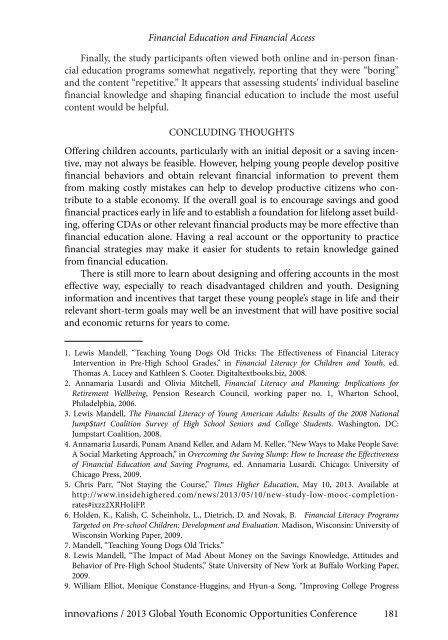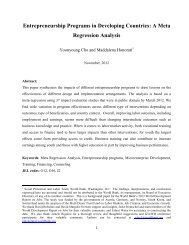Download - Youth Economic Opportunities
Download - Youth Economic Opportunities
Download - Youth Economic Opportunities
- No tags were found...
You also want an ePaper? Increase the reach of your titles
YUMPU automatically turns print PDFs into web optimized ePapers that Google loves.
Financial Education and Financial AccessFinally, the study participants often viewed both online and in-person financialeducation programs somewhat negatively, reporting that they were “boring”and the content “repetitive.” It appears that assessing students’ individual baselinefinancial knowledge and shaping financial education to include the most usefulcontent would be helpful.CONCLUDING THOUGHTSOffering children accounts, particularly with an initial deposit or a saving incentive,may not always be feasible. However, helping young people develop positivefinancial behaviors and obtain relevant financial information to prevent themfrom making costly mistakes can help to develop productive citizens who contributeto a stable economy. If the overall goal is to encourage savings and goodfinancial practices early in life and to establish a foundation for lifelong asset building,offering CDAs or other relevant financial products may be more effective thanfinancial education alone. Having a real account or the opportunity to practicefinancial strategies may make it easier for students to retain knowledge gainedfrom financial education.There is still more to learn about designing and offering accounts in the mosteffective way, especially to reach disadvantaged children and youth. Designinginformation and incentives that target these young people’s stage in life and theirrelevant short-term goals may well be an investment that will have positive socialand economic returns for years to come.1. Lewis Mandell, “Teaching Young Dogs Old Tricks: The Effectiveness of Financial LiteracyIntervention in Pre-High School Grades,” in Financial Literacy for Children and <strong>Youth</strong>, ed.Thomas A. Lucey and Kathleen S. Cooter. Digitaltextbooks.biz, 2008.2. Annamaria Lusardi and Olivia Mitchell, Financial Literacy and Planning: Implications forRetirement Wellbeing, Pension Research Council, working paper no. 1, Wharton School,Philadelphia, 2006.3. Lewis Mandell, The Financial Literacy of Young American Adults: Results of the 2008 NationalJump$tart Coalition Survey of High School Seniors and College Students. Washington, DC:Jumpstart Coalition, 2008.4. Annamaria Lusardi, Punam Anand Keller, and Adam M. Keller, “New Ways to Make People Save:A Social Marketing Approach,” in Overcoming the Saving Slump: How to Increase the Effectivenessof Financial Education and Saving Programs, ed. Annamaria Lusardi. Chicago: University ofChicago Press, 2009.5. Chris Parr, “Not Staying the Course,” Times Higher Education, May 10, 2013. Available athttp://www.insidehighered.com/news/2013/05/10/new-study-low-mooc-completionrates#ixzz2XRHoIiFP.6. Holden, K., Kalish, C. Scheinholz, L., Dietrich, D. and Novak, B. Financial Literacy ProgramsTargeted on Pre-school Children: Development and Evaluation. Madison, Wisconsin: University ofWisconsin Working Paper, 2009.7. Mandell, “Teaching Young Dogs Old Tricks.”8. Lewis Mandell, “The Impact of Mad About Money on the Savings Knowledge, Attitudes andBehavior of Pre-High School Students,” State University of New York at Buffalo Working Paper,2009.9. William Elliot, Monique Constance-Huggins, and Hyun-a Song, “Improving College Progressinnovations / 2013 Global <strong>Youth</strong> <strong>Economic</strong> <strong>Opportunities</strong> Conference 181
















